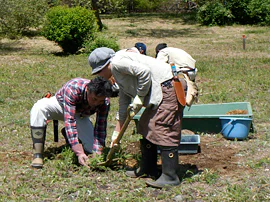Conserving Biodiversity
Conserving Biodiversity

Why is it necessary to conserve species that are increasingly at risk of extinction?
Each species interacts with others, shaping the ecosystems in which they live. Therefore, the extinction of individual species can lead to the collapse of ecosystems, which in turn may ultimately affect human societies. In fact, it is estimated that the biodiversity crisis that began in the late 20th century due to human activities could lead to the sixth mass extinction in Earth's history if no measures are taken. Moreover, a wide variety of organisms contain substances and traits that are beneficial to humanity. If a species goes extinct before it can be studied, we risk losing a valuable resource forever.
Within this context, the Tsukuba Botanical Garden is committed to protecting plant diversity by focusing on living plants. This is because only living plants shape ecosystems, provide valuable resources, and botanical gardens are the only places where
they can be preserved.
So far, the Tsukuba Botanical Garden has focused on the conservation of wild plants from Asia, primarily Japan. In particular, the conservation of endangered species is treated as a top priority, and as of March 2014, 555 of Japan’s 2,155 endangered plant
species are being cultivated and preserved at the garden.
To ensure that preserved plants can be used for ecosystem restoration, the garden accumulates data necessary for conservation and restoration, including reliable records of the history of preserved specimens and studies on their genetic and ecological characteristics. Furthermore, as a pilot project for restoring wild populations from preserved specimens, the garden is working on reintroducing species that have become extinct in the wild.
Valuable plants damaged by grazing goats.
- Valuable plants damaged by grazing goats.
- Endangered Plant Species in Japan
- Why are they endangered?
Conservation Efforts at the Tsukuba Botanical Garden
Research on the Evolution and Conservation of Endangered Plants
Research on the Evolution and Conservation of Endangered Plants